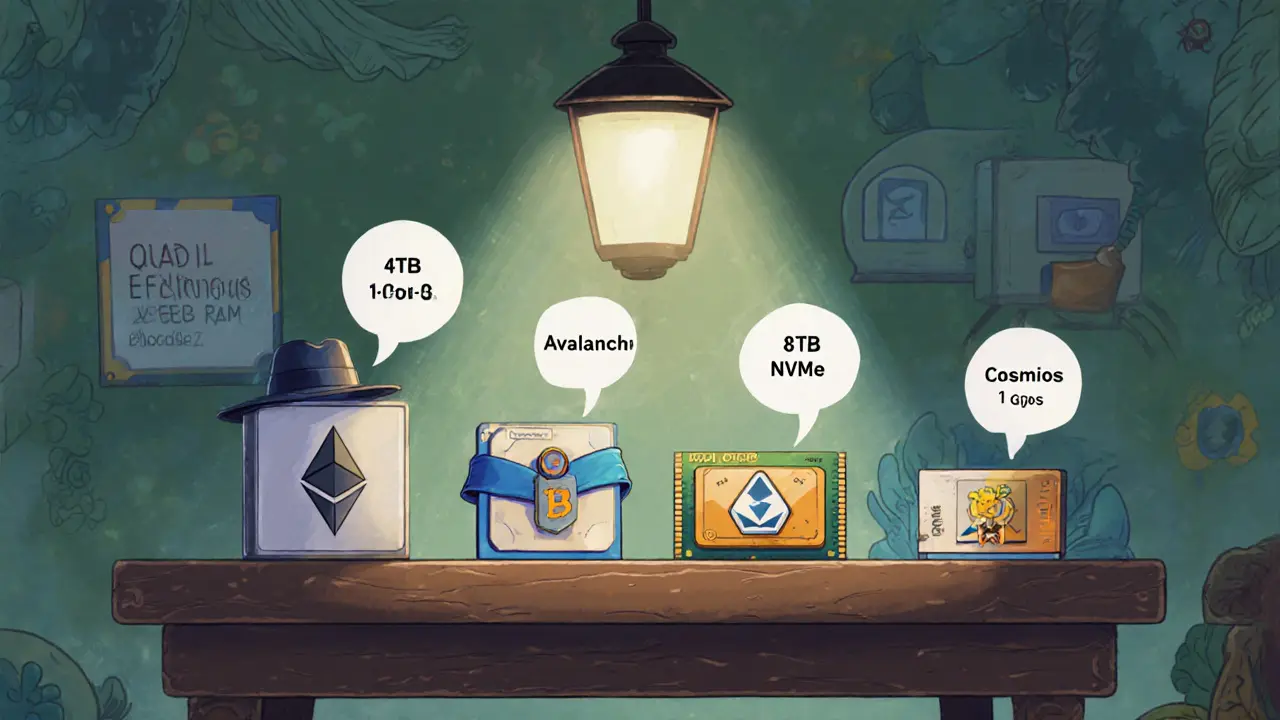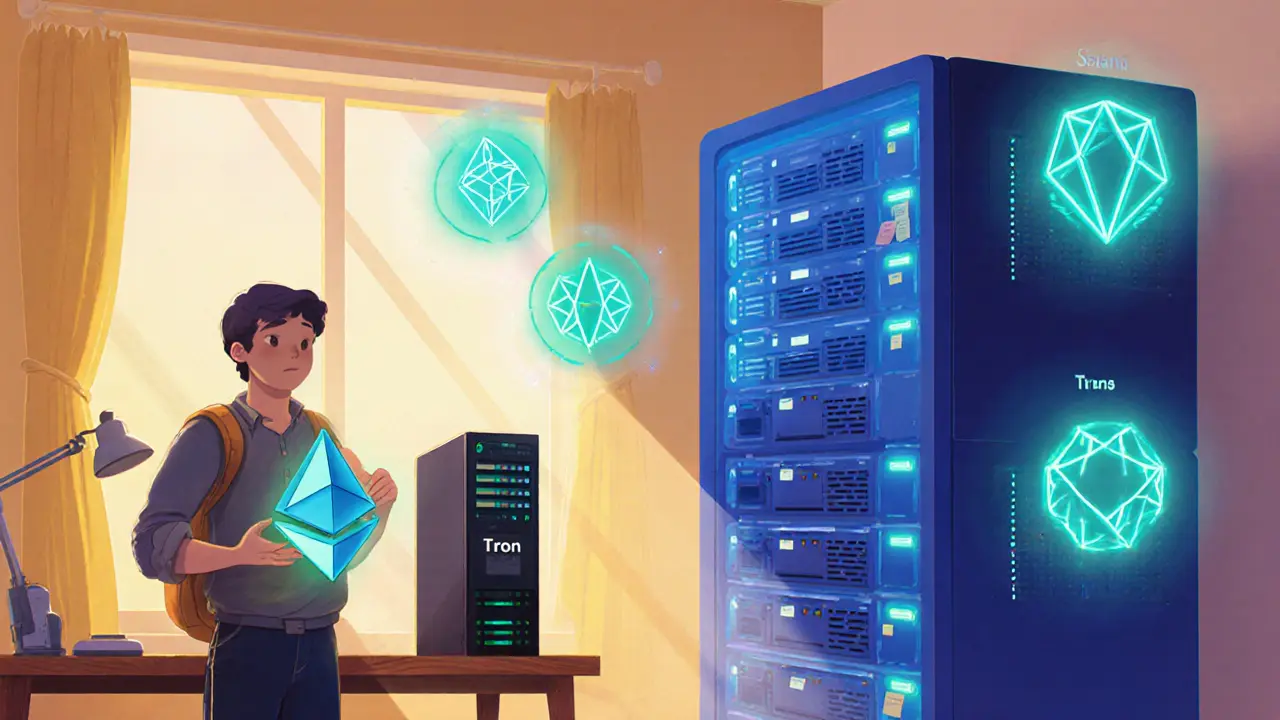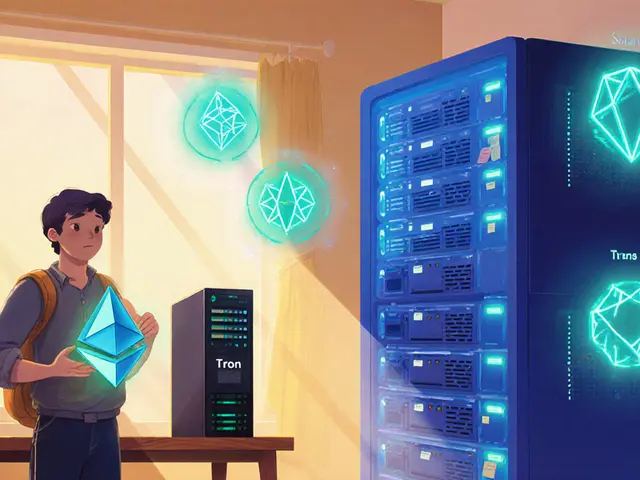Blockchain Validator Requirements Calculator
Hardware Requirements
CPU: Quad-core (x64/arm64)
RAM: 32 GB DDR4
Storage: 4 TB NVMe SSD
Bandwidth: 10 Mbps symmetric
Staking Requirements
Minimum Stake: 32 ETH (~$84K)
Operational Cost Estimate
Monthly Server Cost: $150 - $250
Electricity: ~$20 - $50/month
Bandwidth: Included in server cost
Ever wonder why some blockchain networks need a small home server while others require a mini‑data‑center? The answer lies in the blockchain validator requirements that each protocol sets for its validators. Getting those numbers right can mean the difference between steady rewards and a costly flop.
Key Takeaways
- Hardware needs range from a modest 8‑core VM for Ethereum to a 12‑core, 256GB RAM rig for Solana.
- Staking capital varies wildly - 32ETH (≈$84K) for Ethereum, 2,500AVAX for Avalanche, up to 30millionSUI for Sui.
- Operational costs include bandwidth, electricity, and network‑specific fees (e.g., Solana voting fees).
- Consensus type (PoS, DPoS, BFT) dictates how many validators you need and how rewards are shared.
- Choosing a validator setup hinges on budget, technical skill, and the network’s decentralisation goals.
What Is a Validator?
Validator is a specialized node that orders transactions, creates new blocks, and secures the network by participating in the consensus process. In proof‑of‑stake (PoS) ecosystems, validators lock up a certain amount of the native token - called staking - to earn the right to propose and attest to blocks. If they act dishonestly or go offline, they can lose part of that stake, a penalty known as slashing.
Technical Infrastructure Across Major Networks
Hardware specs reflect the throughput and security model of each chain. Below is a quick rundown of the most common requirements as of 2025.
Ethereum (Proof of Stake)
Ethereum’s beacon chain is relatively gentle on hardware. The official EthStaker guide recommends:
- Quad‑core CPU (x64 or arm64)
- 32GB DDR4 RAM
- 4TB NVMe SSD
- 10Mbps symmetric internet with no caps
- UPS backup
Most validators run these specs on a small dedicated server or a cloud VM.
Solana (Proof of History + PoS)
Solana combines Proof of History with Proof of Stake, demanding high‑performance hardware for timestamp verification. Recommended specs include:
- 12‑core / 24‑thread CPU @2.8GHz (SHA, AVX2 support)
- 256GB ECC RAM
- Three NVMe SSDs (500GB accounts, 1TB ledger, 250GB snapshots)
- 1Gbps symmetric connectivity
Hardware cost ranges from $2,600 to $5,000 (excluding bandwidth and electricity).
Tron (Delegated Proof of Stake)
Tron splits validators into regular nodes and Super Representatives. Regular validators need:
- 16‑core CPU @3.0GHz (AMD7950x3D recommended)
- 64GB RAM
- 2.5TB NVMe SSD
Super Representatives bump the specs to 32‑core AMDEPYC CPUs, 128GB+ RAM, and at least 3TB storage.
Cosmos (Tendermint BFT)
Cosmos uses the Tendermint BFT consensus, where validator uptime and stake share are critical. Typical hardware:
- 8‑core CPU
- 16GB RAM
- 500GB SSD
- 10Mbps+ internet
Because Cosmos hubs can be lightweight, many operators run nodes on modest cloud instances.
Avalanche (Proof of Stake)
Avalanche’s primary subnet validators can get by with:
- 4‑core CPU
- 8GB RAM
- 250GB SSD
- 5Mbps bandwidth
Higher‑performance subnets (e.g., X‑Chain) may need more RAM and storage.
Sui (Proof of Stake)
Sui’s high‑throughput design pushes requirements upward. The network suggests:
- 12‑core CPU
- 64GB RAM
- 2TB NVMe SSD
- 1Gbps internet
Staking itself is a bigger hurdle - see the next section.

Financial Staking Requirements and Capital Commitments
Beyond hardware, the amount of native token you must lock up can be a show‑stopper.
- Ethereum - 32ETH (≈$84,000 USD).
- Avalanche - 2,500AVAX for a primary validator, or 25AVAX for delegators.
- Sui - 30millionSUI tokens.
- Cosmos - roughly 33,000ATOM to stay competitive in the top‑180 set.
- Solana - technically 1SOL, but profit calculators point to ~5,700SOL (≈$934K) as the realistic breakeven stake.
- Tron regular validators: no fixed minimum, but Super Representatives typically lock several hundred thousand TRX to be elected.
Liquid‑staking services can lower the entry barrier by pooling small stakes, but they also take a cut of the rewards.
Operational Costs and Revenue Models
Running a node isn’t free. Electricity, bandwidth, and network‑specific fees eat into rewards.
- Solana validators pay up to 1.1SOL (≈$185) daily in voting fees.
- Ethereum charges a modest gas‑fee overhead; most costs come from hardware power.
- Binance Smart Chain shares 90% of transaction fees with validators and burns the rest.
- Mina Protocol’s zk‑SNARK design keeps storage low, slashing operational spend.
Reward structures also differ: Solana’s $217million monthly pool, Binance Smart Chain’s $14.6million, and Ethereum’s variable issuance based on total stake.
Consensus Mechanism Variations and Validator Types
Understanding the consensus model helps you anticipate hardware and capital needs.
- Proof of Stake (PoS) - Validators are chosen proportionally to their stake. Examples: Ethereum, Cosmos, Avalanche.
- Delegated Proof of Stake (DPoS) - Token holders vote for a limited set of block producers. Examples: Tron, EOS.
- Byzantine Fault Tolerance (BFT) - Nodes reach agreement even with malicious actors. Used in Hyperledger Fabric and Ripple.
- Proof of History (PoH) + PoS - Solana adds a cryptographic timestamp to speed up ordering.
- Proof of Staked Authority (PoSA) - Binance Smart Chain blends staking with authority roles.
DPoS networks tend to have fewer validators (e.g., Tron’s 27 Super Representatives), which can raise centralisation concerns but lower hardware thresholds.
Choosing the Right Validator Setup
Before you spend cash, ask yourself these questions:
- Budget: Do you have enough capital for the required stake and hardware?
- Technical skill: Can you manage a high‑throughput Solana node, or are you more comfortable with a modest Ubuntu VM?
- Risk tolerance: Are you okay with potential slashing penalties?
- Geographic constraints: Some jurisdictions tax staking rewards heavily.
- Community support: Networks with active validator forums (e.g., Ethereum’s Discord) make troubleshooting easier.
Many newcomers start with cloud‑based validators on Ethereum or Avalanche to test the waters before scaling up to Solana or Tron.
Comparison of Hardware & Staking Requirements
| Blockchain | CPU | RAM | Storage | Bandwidth | Minimum Stake |
|---|---|---|---|---|---|
| Ethereum | Quad‑core (x64/arm64) | 32GB DDR4 | 4TB NVMe SSD | 10Mbps symmetric | 32ETH (~$84K) |
| Solana | 12‑core / 24‑thread @2.8GHz | 256GB ECC | 2.25TB (accounts+ledger+snapshots) | 1Gbps symmetric | ~5,700SOL (~$934K for profit) |
| Tron | 16‑core (regular) / 32‑core (SR) | 64GB (regular) / 128GB+ (SR) | 2.5TB (regular) / 3TB+ (SR) | 10Mbps+ | Variable - SRs often lock >100KTRX |
| Cosmos | 8‑core | 16GB | 500GB SSD | 10Mbps+ | ≈33,000ATOM |
| Avalanche | 4‑core | 8GB | 250GB SSD | 5Mbps | 2,500AVAX (primary) |
| Sui | 12‑core | 64GB | 2TB NVMe SSD | 1Gbps | 30MSUI |
Next Steps & Troubleshooting
If you’re ready to spin up a validator, follow this quick checklist:
- Pick a blockchain that matches your capital and technical comfort.
- Secure the required stake in a cold wallet before launching.
- Deploy a VM or dedicated server that meets the hardware table above.
- Install the official client software, enable automatic updates, and set up monitoring (Prometheus + Grafana works well).
- Test uptime for at least 72hours before announcing to delegators.
Common pitfalls:
- Network jitter: Even a brief dip below the required bandwidth can trigger penalties on Solana.
- Disk I/O saturation: Use NVMe drives; SATA SSDs often choke under high transaction loads.
- Stake volatility: Keep an eye on token price - a sudden dip can make your locked capital feel larger than expected.
When issues arise, consult the network’s official Discord or Telegram channels - the validator community is usually quick to help.
Frequently Asked Questions
How much does it cost to run an Ethereum validator?
Beyond the $84K stake, expect $150-$250 per month for a 4TB NVMe server, plus electricity and bandwidth. Cloud options cost roughly $200-$300 monthly.
Can I start a Solana validator with less than 5,700 SOL?
Technically yes - 1SOL unlocks the node - but without enough delegated stake you’ll lose money due to voting fees. Most operators wait until they can attract several thousand SOL.
What happens if my validator goes offline?
Each network defines penalties. Ethereum slashes a fraction of your 32ETH, Solana deducts voting fees, and Tron can temporarily remove you from the active set. Consistent uptime is essential.
Are cloud validators safe?
They’re generally safe if you choose reputable providers (AWS, GCP, Azure) and encrypt your keys with a hardware security module. The main risk is provider outages, so multi‑region setups help.
Which blockchain offers the lowest barrier to entry?
Avalanche’s 2,500AVAX requirement and modest hardware make it the most accessible for newcomers, followed by Ethereum’s well‑documented process.







LeAnn Dolly-Powell
October 10, 2025 AT 05:47Pro tip: Use a UPS. One power flicker and your node gets penalized. I learned the hard way. 😅
Anastasia Alamanou
October 10, 2025 AT 21:31Rohit Sreenath
October 11, 2025 AT 21:08Sam Kessler
October 12, 2025 AT 07:17Steve Roberts
October 13, 2025 AT 03:56John Dixon
October 13, 2025 AT 15:44Brody Dixon
October 13, 2025 AT 23:46Mike Kimberly
October 14, 2025 AT 04:17angela sastre
October 15, 2025 AT 00:14Patrick Rocillo
October 15, 2025 AT 10:59Aniket Sable
October 15, 2025 AT 13:56Santosh harnaval
October 16, 2025 AT 13:33Claymore girl Claymoreanime
October 16, 2025 AT 22:15Will Atkinson
October 17, 2025 AT 01:04monica thomas
October 17, 2025 AT 23:41Edwin Davis
October 18, 2025 AT 08:54emma bullivant
October 18, 2025 AT 10:19Michael Hagerman
October 18, 2025 AT 19:12